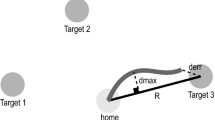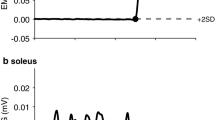Abstract
Objective
Central nervous system reorganization following spinal cord injury (SCI) may cause functional changes in the motor tracts in patients in whom increased auditory startle responses (ASRs) have been previously reported. We hypothesized that if increased ASRs in patients with incomplete SCI were due to compensatory mechanisms, these changes would be related to severity and/or localization of the lesion.
Methods
We examined ASR characteristics in 29 SCI patients and 14 age-matched healthy volunteers. Fourteen patients had incomplete and 15 complete SCI; 10 patients had cervical and 19 thoracolumbar SCI. Five auditory stimuli were applied binaurally to subjects in a sitting position, with a 5-min interstimulus interval. Surface electromyographic recordings were obtained from orbicularis oculi (OOc), sternocleidomastoid (SCM), biceps brachii (BB), and tibialis anterior (TA) muscles.
Results
ASR probability was significantly higher and area-under-the-curve was significantly larger in SCM and BB in patients than in controls. ASR latency was significantly shorter in SCM and BB in patients with cervical than in those with thoracolumbar SCI (p < 0.02), but there were no statistically significant differences between complete and incomplete SCI (p > 0.1). Time span since onset correlated significantly with ASR area in OOc, SCM and BB (p < 0.05).
Conclusion
The capability of the adult central nervous system to reorganize its circuits over time for improved functionality following injury is probably the key to understanding the increased ASRs in patients with SCI. The exaggeration of the startle reflex is potentially important since it may be useful for augmenting voluntary movement in the clinical rehabilitation of patients with SCI.
Similar content being viewed by others
References
Antal M (1984) Termination areas of corticobulbar and corticospinal fibres in the rat. J Hirnforsch 25:647–659
Bareyre FM, Kerschensteiner M, Raineteau O, Mettenleiter TC, Weinmann O, Schwab ME (2004) The injured spinal cord spontaneously forms a new intraspinal circuit in adult rats. Nat Neurosci 7:269–277
Brasil-Neto JP, Valls-Sole J, Pascual- Leone A, Cammarota A, Amassian VE, Cracco R, Maccabee P, Cracco J, Hallett M, Cohen LG (1993) Rapid modulation of human cortical motor outputs following ischaemic nerve block. Brain 116:511–525
Brown P, Rothwell JC, Thompson PD, Britton TC, Day BL, Marsden CD (1991) New observations on the normal auditory startle reflex in man. Brain 114:1891–1902
Carlsen AN, Chua R, Inglis JT, Sanderson DJ, Franks IM (2004) Can prepare responses be stored subcortically? Exp Brain Res 159:301–309
Davis M, Gendelman DS, Tischler MD, Gendelman PM (1982) A primary acoustic startle circuit: lesion and stimulation studies. J Neurosci 2:791–805
Gallager DW, Pert A (1978) Afferents to brain stem nuclei (brain stem raphe, nucleus reticularis pontis caudalis and nucleus gigantocellularis) in the rat as demonstrated by microiontophoretically applied horseradish peroxidase. Brain Res 144:257–275
Jankelowitz SK, Colebatch JG (2004) The acoustic startle reflex in ischemic stroke. Neurology 62:114–116
Koch M (1999) The neurobiology of startle. Prog Neurobiol 59:107–128
Kofler M, Müller J, Valls-Solé J (2006) Auditory startle responses as a probe of brainstem function in healthy subjects and patients with movement disorders. Suppl Clin Neurophysiol 58:232–248
Kumru H, Valls-Sole J (2006) Excitability of the pathways mediating the startle reaction before execution of a voluntary movement. Exp Brain Res 169:427–432
Kumru H, Urra X, Compta Y, Castellote JM, Turbau J, Valls-Solé J (2006) Excitability of subcortical motor circuits in Go/noGo and forced choice reaction time tasks. Neurosci Lett 406:66–70
Levy WJ, Amassian VE, Traad M, Cadwell J (1990) Focal magnetic coil stimulation reveals motor cortical system reorganized in humans after traumatic quadriplegia. Brain Res 510:130–134
Lotze M, Laubis-Herrmann U, Topka H (2006) Combination of TMS and fMRI reveals a specific pattern of reorganization in M1 in patients after complete spinal cord injury. Restor Neurol Neurosci 24:97–107
Lotze M, Laubis-Herrmann U, Topka H, Erb M, Grodd W (1999) Reorganization in the primary motor cortex after spinal cord injury – A functional Magnetic Resonance (fMRI) study. Restor Neurol Neurosci 14:183–187
Marino RJ, Barros T, Biering-Sorensen F, Burns SP, Donovan WH, Graves DE, Haak M, Hudson LM, Priebe MM; ASIA Neurological Standards Committee 2002 (2003) International standards for neurological classification of spinal cord injury. J Spinal Cord Med 26(1):S50–S56
Prendergast J, Misantone LJ (1980) Sprouting by tracts descending from the midbrain to the spinal cord: the result of thoracic funiculotomy in the newborn, 21-day-old, and adult rat. Exp Neurol 69:458–480
Raineteau O, Schwab ME (2001) Plasticity of motor systems after incomplete spinal cord injury. Nat Rev Neurosci 2:263–273
Shammah-Lagnado SJ, Negrao N, Silva BA, Ricardo JA (1987) Afferent connections of the nuclei reticularis pontis oralis and caudalis: a horseradish peroxidase study in the rat. Neuro science 20:961–989
Topka H, Cohen LG, Cole RA, Hallett M (1991) Reorganization of corticospinal pathways following spinal cord injury. Neurology 41:1276–1283
Valldeoriola F, Valls-Solé J, Tolosa E, Ventura PJ, Nobbe FA, Marti MJ (1998) Effects of a startling acoustic stimulus on reaction time in different parkinsonian syndromes. Neurology 51:1315–1320
Valls-Solé J, Rothwell JC, Goulart F, Cossu G, Muñoz E (1999) Patterned ballistic movements triggered by a startle in healthy humans. J Physiol 516:931–938
Wilkins DE, Hallett M, Wess M (1986) Audiogenic startle reflex in man and its relationship to startle syndromes. A review. Brain 109:561–573
Wu CW, Kaas JH (2002) The effects of long-standing limb loss on anatomical reorganization of the somatosensory afferents in the brainstem and spinal cord. Somatosens Mot Res 19:153–163
Author information
Authors and Affiliations
Corresponding author
Rights and permissions
About this article
Cite this article
Kumru, H., Vidal, J., Kofler, M. et al. Exaggerated auditory startle responses in patients with spinal cord injury. J Neurol 255, 703–709 (2008). https://doi.org/10.1007/s00415-008-0780-3
Received:
Revised:
Accepted:
Published:
Issue Date:
DOI: https://doi.org/10.1007/s00415-008-0780-3




